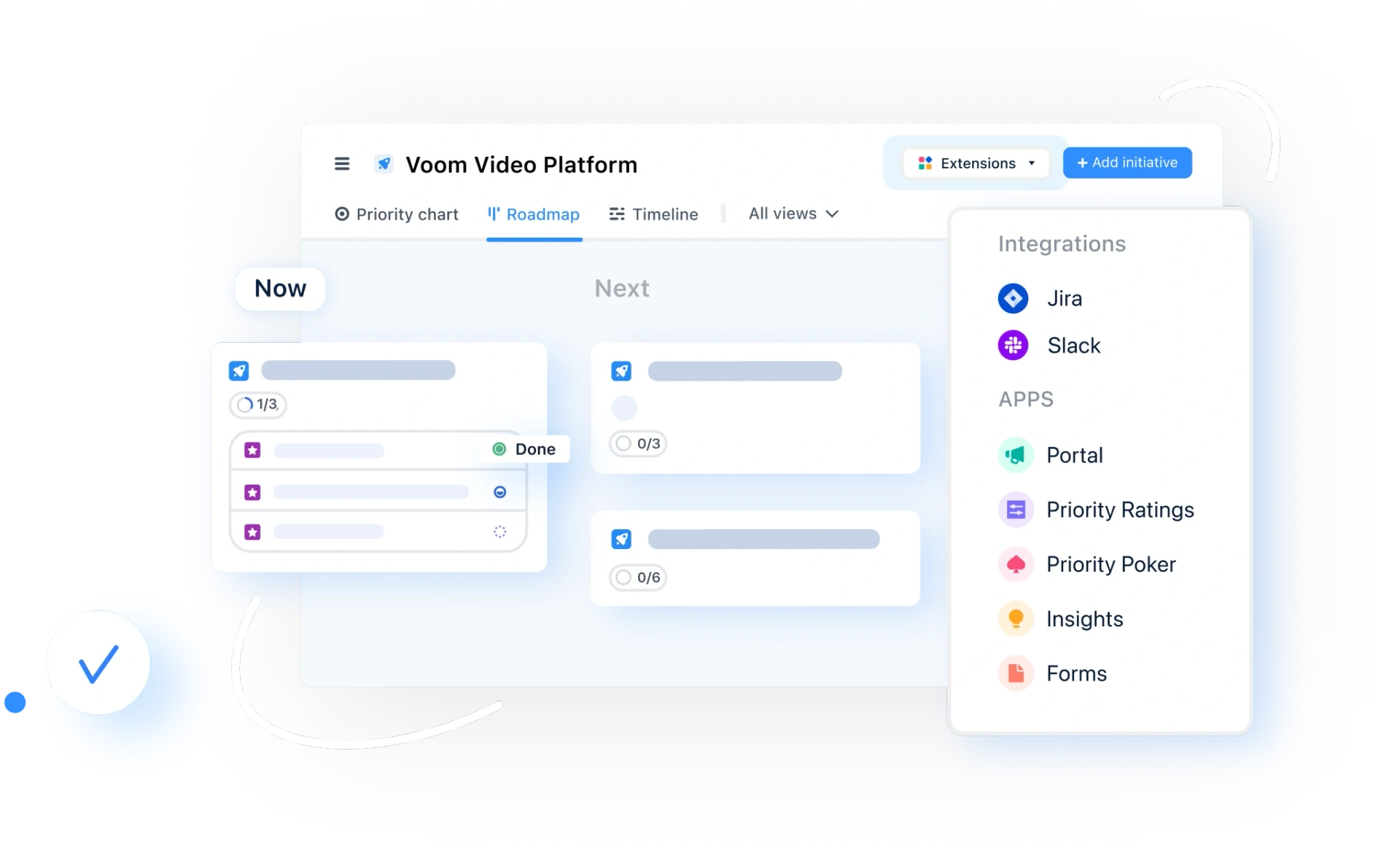Website Traffic
Traffic is considered crucial to determining a website’s success. For businesses and organizations, understanding website traffic and identifying ways to improve it is fundamental for consistent growth.
Learn how product leaders can translate website traffic data into smarter roadmaps, prioritization, and OKRs, and how airfocus helps bridge data and strategy.
What is website traffic? (and why it’s more than a marketing KPI)
Definition of website traffic
Website traffic refers to the volume of users visiting a website. How many people visit a website will depend on the website’s purpose, the visitors’ own goals, and the way in which they discovered the site.
What is website traffic? Website traffic refers to the number of users who visit your site within a particular period of time. There are multiple different types of website traffic, covering various sources and routes, including:
Organic: Discovering a site on search engine results pages (SERPs)
Paid: Reaching a site through a sponsored ad
Referral: Clicking on a link in one site to reach another site
Direct: Typing the URL manually into the address bar to skip SERPs
Website traffic typically counts each individual user as one unique visitor, no matter how many times they visit. But what is website traffic in relation to product management? Why should you pay attention to data on site activity and user behavior?
Website traffic in product management shows how users interact with a site and how the site is performing. It is a quantitative measure of a site’s success: assessing easily accessible data can reveal areas for improvement.
Without this data, product teams may have to guess about a site’s performance and rely on assumptions when creating a product roadmap.
Why website traffic matters for product leaders
Website traffic isn’t just about marketing. It can be a powerful product signal. For product leaders, traffic data offers a direct view into how users discover, explore, and interact with your product through your website.
By analyzing website traffic, product leaders can:
Understand feature adoption
Instead of guessing which features are resonating, website traffic shows exactly what users are engaging with. This makes it easier to identify which parts of your product are gaining traction and which ones you may need to rethink.
Spot friction points early
Sudden drops in traffic or high bounce rates can signal usability issues, broken flows, or unclear messaging. When you catch these signals early, product teams can fix problems before they impact conversion or retention rates.
Prioritize with confidence
Website traffic trends reveal what users care about most. If a specific page, feature, or topic consistently draws attention, it may warrant more investment. This helps product leaders prioritize roadmaps based on actual user behavior, not assumptions.
Boost user engagement
Knowing where users spend time helps you improve the product experience where it matters most. Whether it's simplifying navigation, enhancing content, or optimizing for conversions, traffic data gives you the evidence to act with purpose.
Ultimately, web traffic data helps product leaders make smarter, faster decisions by turning user activity into actionable insight. It connects product strategy with real user behavior, so you’re always building with impact in mind.
Using traffic insights across the product lifecycle
Product leaders often leverage traffic data throughout the product lifecycle to make informed, clearer decisions. Tracking the right web traffic metrics for product teams is critical, and making data-driven changes will help you consistently improve your site to boost user engagement.
Let’s explore how product leaders can leverage website traffic in product management throughout different stages of the product lifecycle.
During product discovery
Studying traffic data can help you identify high-interest topics and pain points in the discovery stage. Traffic insights reveal how users navigate a platform, highlighting the most popular pages, paths, and drop-off points.
You can use this data to validate or invalidate assumptions about user behavior, creating a tighter focus on user needs. As you dig deep into visitors’ on-site activities, you’ll learn whether they’re taking the actions you need them to or missing the most critical areas of the site entirely.
During roadmap planning
A well-crafted product roadmap depends on more than just intuition. It requires a deep understanding of user behavior. Website traffic data offers valuable signals that help product leaders align their roadmap with actual user needs and interests.
By analyzing which pages, features, and content users are engaging with most, product teams can:
Validate demand for certain capabilities or areas of focus
Identify gaps or opportunities based on user intent and drop-off points
Prioritize initiatives that reflect real patterns in user behavior
Rather than planning based on assumptions or internal opinions, traffic data grounds your roadmap in evidence. For example, if a particular product feature consistently drives high traffic and engagement, it may indicate strong user demand, making it a candidate for further development or investment.
Traffic insights also help ensure the roadmap reflects business goals. You can use this data to support key decisions, communicate priorities across teams, and keep product development focused on high-impact outcomes.
During prioritization and scoring
What is website traffic analysis for if not making the best improvements and providing users with the best experience? But prioritizing features isn’t just about what sounds like a good idea. It’s about what will have the most impact. Website traffic data gives product leaders a concrete way to assess potential value before investing time and resources.
Understanding what is website traffic, and how users interact with different parts of your site or product helps you make smarter decisions about where to focus your efforts. By analyzing traffic patterns, you can:
Identify high-interest areas where new features might have the most visibility and impact
Evaluate whether a proposed update aligns with actual user behavior and intent
Support prioritization decisions with evidence that’s easy to share with stakeholders
Traffic trends also help balance effort versus reward. For example, adding a new feature to a low-traffic page might not deliver much return, while enhancing a high-traffic area could drive meaningful results.
By tying user behavior directly to feature planning, you can score opportunities with more confidence and build alignment across teams. This approach helps shift prioritization from opinion-based discussions to data-informed decisions.
During OKRs and success measurement
Once a product or feature is live, website traffic data becomes a key tool for tracking progress against your OKRs and KPIs. It shows how users are interacting with the product and whether those interactions support your broader goals.
Some of the most useful web traffic metrics for product teams include:
Bounce rate: Are users finding value, or leaving quickly?
Time on page & session duration: Are they engaging deeply with content or features?
Pages per session: Are they exploring beyond the initial entry point?
Scroll depth: Are they seeing the most important information?
Conversion rate: Are they completing desired actions?
These insights help you connect product performance to real user behavior. Instead of relying on assumptions or delayed reporting, you get real-time feedback that supports faster iteration and more confident decision-making.
Tying these traffic metrics to your OKRs ensures your success criteria are grounded in how users actually experience your product, helping you drive continuous improvement across the product lifecycle.
How airfocus helps turn traffic data into action
To put web traffic data to use, product leaders and teams need the right tools. Here’s how airfocus can help you make the most of traffic data.
Use integrations and custom fields for tracking traffic insights
With a huge range of integrations to choose from, airfocus makes it easy to gather and track traffic insights from multiple sources. Use the tools you rely on daily to gather and analyze your website traffic product management data.
You can also create custom views and fields to track specific metrics related to traffic and user behavior. Use release and timeline views to chart a feature’s progress, turning a plan into action with at-a-glance visibility.
Build scoring models and views to survey high-impact opportunities
Prioritization is vital for building products with the most impactful features, but it can be difficult if your tools don’t offer multiple scoring frameworks. With airfocus, you can create your own prioritization frameworks to drive your decision-making process and facilitate better conversations with your teams.
You’ll gain a deeper understanding of which features will deliver the best user experience, rather than relying on guesswork. You can also visualize your:
Strategic initiatives and opportunities
Quick wins
Time-wasting ideas
This will show what offers the most value and help reduce the risk of failure.
With airfocus, you can also work customer insights into your prioritization process. Our customer feedback software centralizes information from multiple channels, providing your team with comprehensive insights into users' experiences on your site.
Analyzing this feedback will help you understand the most-requested ideas and what users genuinely need.
Delve deeper into planning and analytics
With AI Assist, you can automate repetitive tasks, increase your productivity, and save valuable time. Here’s how:
Generate ideas and drafts: AI Assist can help you quickly generate ideas and put together first drafts, giving you a chance to put something tangible on a blank page even if you’re low on inspiration.
Analyze customer feedback: AI Assist streamlines feedback analysis, providing concise summaries to convey the sentiment of users’ responses in less time.
Avoid jargon and confusion: Some stakeholders may struggle to make sense of information covering technical areas, which could slow your product management down a little. With AI Assist, you can automatically tone down the jargon and make text more understandable to all stakeholders.
Bring clarity to your product strategy with data-driven insights
Today’s product leaders need clear, actionable data, not guesswork. With airfocus, you can track the most relevant web traffic metrics for product teams, connect insights across tools, and make smarter decisions at every stage of the product lifecycle.
From prioritizing features to measuring outcomes, airfocus helps you turn traffic data into strategic action. Built for modern teams, airfocus combines AI features, flexible integrations, and customer feedback tools to streamline your product management workflow. Ready to get started? Book your personalized demo and see how airfocus can help you build better products today.

General FAQ

Glossary categories
Experience the new way of doing product management

Experience the new way of doing product management








